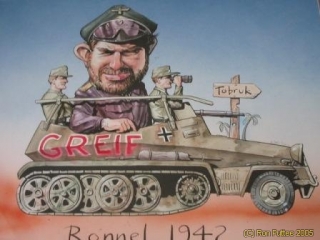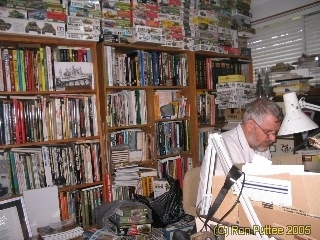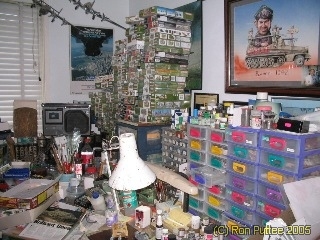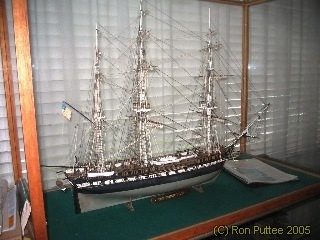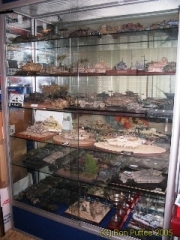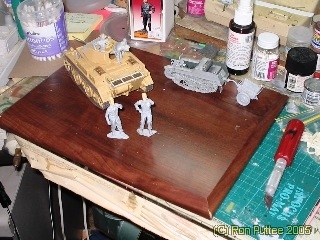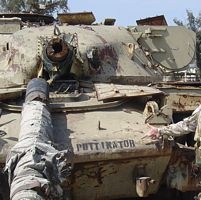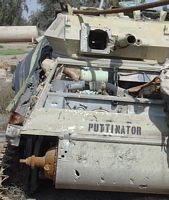Just Reminiscing?
– or Will Modelling Ever Be the Same Again?
Ron Puttee is our only foundation member still active in AMMS. They have a habit of running screaming into the night after meetings. That full moon’ll do it every time!
Ron is well-known both in Australia and overseas, and has helped a lot of modellers over the years. He is always generous with his time be it with advice or reference material. In many ways, a true mentor. His penchant for Western Desert themes has earned him the nickname of “Ronnel” (amongst others, but we wouldn’t want to hurt his feelings, unduly).
This is the first in a series of articles in which Ron will, in his somewhat unique (idiosyncratic?) style, share with us some of the many techniques he has learned (and learned from others) in over thirty years of modelling. In this article, Ron introduces himself and explains how he got into modelling in the first place.
Here beginneth the lesson…
In the Beginning:
One dark and cold English winter’s evening, when I was about ten years old, Dad brought home a small plastic bag containing the parts to build a small plastic airplane (an Airfix kit if I remember). We sat down together that following weekend to build our first (and only) model together. Why he brought it home I have no idea. Dad was a bit of a handy man and liked working with his hands, so maybe it was his way of showing me the way and letting me experience first hand the satisfaction of finishing a “project”. As the build progressed he must have repeated a dozen times that the secret to successful model building was to carefully “follow the instructions”. Painstakingly, we followed each step in the laid down plan.
A careful and considered build was progressing, and almost came to a satisfactory conclusion, except for, well…
“What idiot put the painting instructions after the construction??!!”
No one said you had to read ALL of the instructions first, well, at least not back then they didn’t.
There was the little pilot, sat cozily in his cockpit, the almost clear canopy glued neatly and snugly around him. But we had still to paint the pilot’s helmet white! It wasn’t amusing at the time, but it’s a fond memory now, especially since Dad passed on.
(Ed: It is worth noting that Ron’s father Les was a Leading Hand in Combined Operations during the latter part of WWII. He was Coxswain of an LCT during the the D-Day operation at Omaha Beach, landing Yanks on the beach under fire. You can find Ron’s obituary for his Dad here D-Day, Normandy & Beyond. Go to the Veterans tab at the top of the page and look for story 106 – Les Puttee. Sorry – they won’t let me do a direct link! Not even a sneaky one!)
So, my young introduction to a fondness of smelling glue on plastic came about through no real fault of my own. My Father made me do it!!! Well, that’s the story I tell my wife anyway. Now, nearly forty years later, the spare room has kits stacked to the ceiling, and my modelling room looks like a Pacific War Kamikaze hit.
After such a promising start, I built just about anything in a bag or box. Ships, planes (mostly) and I accumulated a fair collection of those early Aurora figures. Especially the Musketeers, with the real metal swords and the feathers in their hats – hi-tech then. All valuable experience! Matt paints, liquid poly and acrylics were unheard of. As were airbrushes, thinning your own paint, reams (rooms?) of reference, and the only resin I knew of oozed from trees. A modelling club was something you read about on the cover of Mum’s Woman’s Day. Or on the inside of the magazines at the barber’s.
In the early days I remember only making the real big mistakes once, you know – spilling paint on the tablecloth, letting my little brother pose for pictures with a couple of my latest “masterpieces”, and of course experiencing the agony after leaving your latest freshly painted project to dry in the afternoon sun!
Time moved on, and military service (RAN VS816 Squadron) got in the way of the hobby.
Although long, quiet weekends during basic training spawned a few builds, and an occasional punch up, when the uninitiated decided that setting fire to a squadron of Battle of Britain fighters, and watching them crash and burn was more exciting than watching them sit on top of my locker “doing nuthin”.
So Unto Arms!
How did I get absorbed into the fascinating world of 1:35th scale armoured vehicles and the never sated study thereof? Especially when many fellow modelers over the years have asked me, “where does building armor come in?”, after finding out about my classic grounding in aircraft and ship modeling, and more than 20 years service in the Australian Fleet Air Arm. This has been a source of comment at many a competition, “what does he know about planes – he builds armour?!”.
Well, back in the mid 70’s and busy in the shed one day while my “baby” brother was visiting, I was putting the final touches to a large Monogram B17 with detailed interior, and was just placing the last hatch on the Fortress (which consequently covered up most of the painstaking detail applied therein). Barry walked in carrying what was then the first of many armour models he would be doing. These were a couple of the early Tamiya kits, and although they appeared somewhat simplified in their “out of the box” build, I was struck by all that lovely exterior detail, the additional stowage and splashed mud. And, Gawd help us, you could clearly see the figures, as they were riding on the outside!
It was only a couple of weeks later I found myself assembling, making and painting the first of some 100 or more individual military model builds.
I have thought about it a few times on the odd lonely pre-competition build in the early hours and, well, we have to admit, the practice of our “art” (and most art for that matter), is an anti-social existence. That is, until we crawl out of our paint-fumed and sweaty burrows into the daylight and once more rejoin society to take our efforts to the local art exhibition, modeling club or competition.
To get our hobby into perspective, and for anyone else who doesn’t immediately relate to it, the term “three dimensional art” (as a longtime friend and modeller once described it) is, I believe, the best description that encompasses the construction and detailing (especially to real life), and the finishing and painting techniques, that we modellers practice, for weeks at a time on occasions.
So in the end, for me at least, the penultimate pleasure (well it ain’t ever been as good as “you know what”), is producing a military vehicle or diorama that is as close as I can get it to real life. And as a consequence, comments from non-modellers like “how do you make it look so real?” are, for me, the most satisfying.
Text (C) Ron Puttee 2006
Additional Images
| The latest project – got some way to go yet!! | |
| A NEW nickname??? Is there no end to the spread of his fame? Those new AMMS Iraq guys must be pretty keen! |

